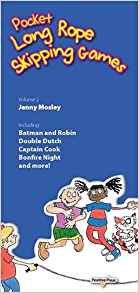Pocket Long Rope Skipping Games: 2
Jennifer Mosley, Mark Cripps
Paperback
(Positive Press Ltd, Dec. 22, 2016)
It is unclear when the first skipping rope was invented: some say jumping rope originated in ancient China; some say that the Western style of jumping rope originated in Egypt around 1600 A.D. What is known is that jumping rope, in some form or another, spread through Europe to the Netherlands, and eventually to North America. Early Dutch settlers were some of the first 'rope jumpers' in America - one of the more popular jumping games is called Double Dutch and is included in our little booklet. Whatever its origins, it is clear that, not only is skipping a lot of fun, but it is also a great way to improve fitness, flexibility, coordination and also to develop cognitive and social skills. We love skipping because it is such a sociable activity; it encourages cooperation, concentration, coordination, patience, etiquette - so important in our schools and in life! Skipping also promotes team building in an enjoyable way and helps children develop into social beings as they learn to be around and interact with other children. Skipping also has valuable health benefits: it helps to improve cardio-respiratory fitness, builds muscle strength and helps with flexibility and coordination. Also, the complexity of jumping rope whilst performing other actions requires input from both sides of the brain, thereby stimulating whole brain functioning. The long rope skipping games in this booklet cater for different levels from beginners to more accomplished skippers. The skipping songs in this booklet drive the skipping with their repetitive rhythms and catchy rhymes - which the children will love to learn and chant - and this can really help with spoken language development and memory skills.












